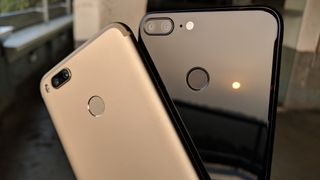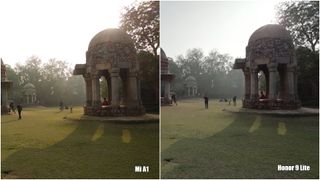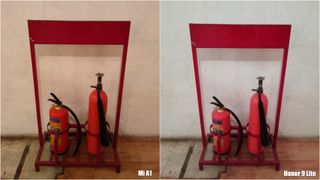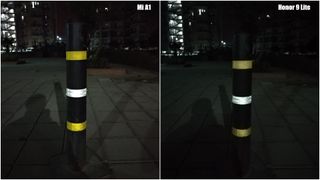Camera Comparison: Honor 9 Lite vs Xiaomi Mi A1
What should be your photography tool under 15K?

Huawei's newest smartphone, the Honor 9 Lite, has a tough battle to fight. It's a beautiful phone, has the right specs for its price, and could suit the consumer's fancy. Yet, it needs to get around the reputation our current budget favourite, the Mi A1, has earned for itself.
The Honor 9 Lite is priced at Rs. 10,999 and Rs. 14,999 for its 3GB and 4GB RAM variants respectively. It has two monochrome cameras on the back and promises great shots. While the phone can go toe-to-toe with the Mi A1 for the most part, buyers in this range will perhaps make the final decision based on its camera quality.
Camera specifications
The Honor 9 Lite has 13MP and 2MP sensors on the front and back. The 13MP sensor is the primary sensor, whereas the 2MP sensor is a monochrome sensor, that Honor also uses to capture depth.
On the other hand, the Mi A1 has a 12MP wide-angle primary lens with f/2.2 aperture (same as the 9 Lite) and a 12MP telephoto lens with f/2.6 aperture. Evidently, the Honor 9 Lite is made to capture more detail and better colours, while the Mi A1 wants to cash in on the portrait mode.
Camera UI
Honor 9 Lite
The Honor 9 Lite has clean and easy to use software. It offers a bunch of modes and settings that can be accessed simply by swiping left or right from the main screen. This has all the basic functions, enabling easy controls. But 40% of the screen is covered by black borders, which leaves limited space for the viewfinder.
You get the camera switching button, flash controls, wide-aperture mode and moving picture mode on top of the screen. Whereas, the gallery shortcut, shutter button and video switch is at the bottom.
Get daily insight, inspiration and deals in your inbox
Get the hottest deals available in your inbox plus news, reviews, opinion, analysis and more from the TechRadar team.
It also has a Pro mode that lets you tweak settings like ISO, exposure, focus etc. There's a pro video mode, night shot, time-lapse, filters, watermark, light painting, panorama and more. It also has shortcuts for touch to capture, capture smiles and object tracking.
Mi A1
The camera UI on Mi A1 is even simpler and allows more space to viewfinder, despite having a smaller screen. The black border remains on the Mi A1 as well, but it's just at the bottom.
On the top, there's a software key to toggle flash, a portrait mode button and a HDR toggle. The bottom has a button to toggle filters, switch cameras, shutter button, gallery shortcut, video and options. Tapping on options takes you to modes and settings. The Mi A1 has a panorama mode, manual/pro mode, beautify, group selfies, square photo and audio. The audio mode allows you to take a photo through voice commands.
On top of the options menu, you'll see a dual camera watermark option and settings icon.
Which is better?
If you like a simple easy-to-use and clutter-free camera UI, MIUI aces at it. If you like experimenting with the camera and need tons of modes to play with, then the Honor 9 Lite can do the job.
Overall, the camera UI on Mi A1 is better because you get to use a larger part of the screen as the viewfinder. The Honor 9 Lite makes things easier by providing modes for specific shooting scenarios, but you can do all of this with the Mi A1 as well. The Honor 9 Lite's camera app takes a split second lesser to open than the Mi A1's.
Natural light

The picture above was shot from the same spot using the Mi A1 and Honor 9 Lite. Here, the colours are warmer on the Mi A1, making it look yellowish in comparison with the Honor 9 Lite's shot. But the colour of the grass and the dome structure are closer to source on the Mi A1. The colours look under saturated on the Honor 9 Lite.
That said, while the Honor 9 Lite fails to produce true-to-source colours, there are areas where it beats the Mi A1. Have a look at the shots below.

The Honor 9 Lite does a better job at judging the scene. In the picture above, the Mi A1 overexposed the background, whereas the Honor 9 Lite managed to control exposure in that area. Look at the sunlit grass behind the tree.

The Mi A1 has higher dynamic range and produces better details in the shadow areas of a scene. In this photo, shadow details are better defined and the intensity of light in the overall frame is spread better as well.
Artificial light

In incandescent lighting, the Honor 9 Lite shines. It captures vibrant and punchy colours and reads the scene pretty well. The Mi A1 showed similar results, but you can see slight smudging from lens flare near the corners, which will often ruin photos.

The Honor 9 Lite again messes up white balance here. The walls look whiter than they should and saturation is off. The Mi A1 produces a slightly oversaturated, but a more pleasant image.
Portraits

The Mi A1 and the Honor 9 Lite can both click good portrait shots. But the Mi A1 uses the telephoto lens to measure depth and then uses software to produce background blur. The Honor 9 Lite is more dependent on camera, lacking a telephoto lens.
The Mi A1 produces better definition in the background blur compared to the Honor 9 Lite. The result is a noticeable more pleasant photo.

None of the phones actually proved to be good for low light portraits. But, if we have to chose one, the Honor 9 Lite did better. The picture above shows how grainy the shot from Mi A1 is, while the shot from 9 Lite still has some details. Neither is acceptable, but the monochrome camera on the 9 Lite allows more light intake.
Low light


Even in low light, the Mi A1 beats the Honor 9 Lite. Be it colours, dynamic range or details, the Mi A1 produced better results. You can see more of the car in the photo above, while the Honor 9 Lite removes the number plate completely.
You can see similar results in the picture of the tree, where the Mi A1 also produced better colours and details.

The pole in the picture above was shot at the same time and spot from both the phones. The Mi A1 managed to capture a better saturated yellow, with decent details.
Verdict
It's difficult to find dissimilarities between these cameras if you're looking at photos on their own screens. Compared side-by-side, the Mi A1 is a noticeably better camera phone. It produces higher details, produces better colours and has higher dynamic range. The Honor 9 Lite is certainly not bad, but in comparative terms, we would have to recommend the Mi A1 over this one.
Sudhanshu Singh have been working in tech journalism as a reporter, writer, editor, and reviewer for over 5 years. He has reviewed hundreds of products ranging across categories and have also written opinions, guides, feature articles, news, and analysis. Ditching the norm of armchair journalism in tech media, Sudhanshu dug deep into how emerging products and services affect actual users, and what marks they leave on our cultural landscape. His areas of expertise along with writing and editing include content strategy, daily operations, product and team management.

